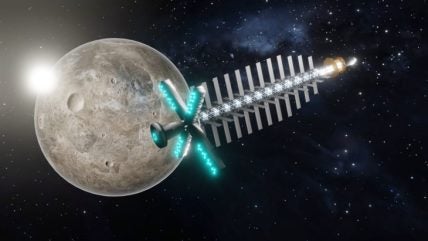
A consortium led by Belgium-based Tractebel (part of France’s Engie) has defined a comprehensive technology roadmap to develop advanced propulsion systems for Europe capable of undertaking long-duration missions, including manned expeditions to Mars. Tractebel heads the consortium of the European Space Agency (ESA)-commissioned RocketRoll project, which aims to harness the potential of Nuclear Electric Propulsion (NEP) for space missions.
The RocketRoll project brings together leading stakeholders in aerospace and nuclear within the consortium that also includes the French Alternative Energies & Atomic Energy Commission (CEA), ArianeGroup, Airbus and Frazer Nash. It also included researchers from the University of Prague, the University of Stuttgart and engineers from OHB Czechspace and OHB System in Bremen. The project, which started in March 2023 and concluded in October, aims to propose a candidate NEP design for a European demonstrator by 2035.
ESA says the ultimate rationale of NEP is to explore beyond Mars orbit where solar power is limited. To develop a tug for long term and distant exploration, a stepwise implementation could be considered with a subscale tug to in-orbit demonstrating the added value of NEP with less demanding missions. In a technology push approach, and in the anticipation for the increasing need of demanding in-space transportation, the study was a first step toward an in-orbit demonstrator of nuclear electric propulsion systems.
The main advantage over chemical reaction is the efficiency of the engines. The advantage over solar electric power input is the larger power output and independence of exposure to direct sunlight, especially enabler for transporting heavy cargo with long time constraints (Moon night management for example) and for exploration beyond Mars orbit. In addition, ESA notes that NEP could have strong synergies with other space application. For instance, nuclear power could be used on the Moon or Mars surface to power future habitats or robotic exploration of the solar system, or in space for other purpose than propulsion. On the propulsion side, the development of high-power electric thrusters for NEP could also be used with non-nuclear power input.
Project RocketRoll (pReliminary eurOpean reCKon on nuclEar elecTric pROpuLsion for space appLications), explores the advantages of using a NEP)tug over classical propulsion systems for the demanding missions expected for the future of space logistics and exploration. It seeks to identify the main safety features for the design and highlight contingency and mitigation measures. It aims to determine what are the existing and missing key elements (technologies, modelling capabilities, testing facilities, etc.) in Europe that will be matured for a nuclear electric tug operational after 2035.
“I am proud to lead such an important initiative in nuclear electric propulsion, which could enable exploration and in-space logistics in Earth Orbit and beyond on a scale that neither chemical nor electrical propulsion could ever achieve,” said Brieuc Spindler, Tractebel’s Innovation Manager & Aerospace Product Manager. “I am committed to navigating the intricate technical and strategic challenges ahead. By leveraging its nuclear expertise and innovative solutions, Tractebel helps advance space technologies and push the boundaries of the final frontier’s exploration.”
European space missions currently depend on external sources for nuclear capabilities. Tractebel’s strategy is to engineer a range of nuclear power solutions, from radioisotope to fission systems, while also contributing to developing a European value chain for nuclear solutions in space applications. This aligns with Europe’s strategy to reduce dependency on critical technologies and strengthen European sovereignty.
“Thanks to its huge energy density, NEP offers disruptive advantages in terms of speed, autonomy, and flexibility,” Tractebel said. “This innovative propulsion technology has the potential to transform space exploration and space mobility by enabling longer-duration missions, potentially shaping the future of interplanetary exploration.”






